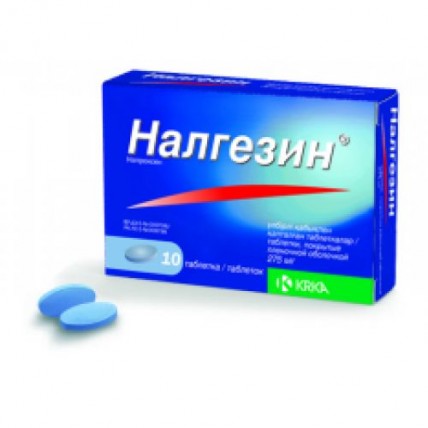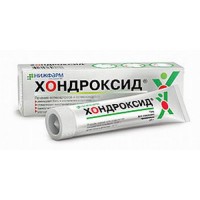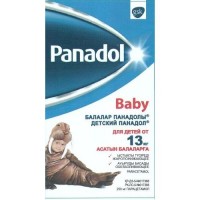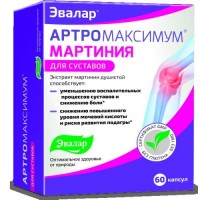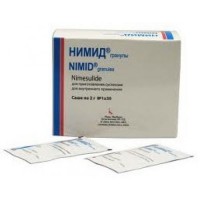Nalgezin® (Naproxen) 275 mg, 10 film-coated tablets
- $6.10
1 tablet of Nalgesin contains
Suction
After oral administration, naproxen sodium is hydrolyzed in gastric acid. Naproxen microparticles are released and quickly dissolve in the small intestine. This leads to accelerated and complete absorption of naproxen, therefore, the concentration in blood plasma that is effective for analgesic action is reached after 15-20 minutes. After taking a single dose of naproxen sodium, peak plasma concentrations are reached within 1-2 hours, and after a single dose of naproxen - within 2-4 hours, depending on the fullness of the stomach. The degree of absorption does not significantly depend on either food or most antacids. The equilibrium concentration is reached after 5 doses, that is, within 2 to 3 days. Plasma levels of naproxen increase proportionately at doses up to 500 mg. At higher doses, they are less proportional; due to the saturation of plasma proteins that bind naproxen, creatinine clearance also increases.
Distribution
At a typical dose, plasma concentrations of naproxen range from 23 mg/L to 49 mg/L. At concentrations up to 50 mg/l, 99% of naproxen binds to plasma proteins. At high concentrations, the amount of unbound active substance increases and at a concentration of 473 mg/l is 2.4%. Due to the extensive binding of plasma proteins, the volume of distribution is small and amounts to only 0.9 l / kg of body weight.
Metabolism and excretion
About 70% of the active substance is excreted unchanged, 60% binds to glucuronic acid or other conjugates. The remaining 30% of naproxen is excreted as the inactive metabolite 6-dimethyl-naproxen.
Approximately 95% of naproxen is excreted in the urine and 5% in the faeces. The half-life is independent of dose and plasma concentration and is 12-15 hours, which allows reaching a steady state within 3 days after the start of twice-daily therapy. Creatinine clearance is dependent on the plasma concentration of naproxen, probably due to an increase in unbound particles of the active substance at higher plasma concentrations of naproxen.
Metabolism in children is similar to that in adults.
Chronic alcoholic liver disease reduces the total plasma concentration of naproxen, but the concentration of unbound naproxen increases.
In the elderly, the plasma concentration of free naproxen increases, although the total plasma concentration remains unchanged.
Nalgesin® is a non-steroidal anti-inflammatory drug. It has anti-inflammatory, analgesic and antipyretic properties. The main mechanism of action is the inhibition of cyclooxygenase, an enzyme that is involved in the formation of prostaglandins. As a consequence, the level of prostaglandin in various body fluids and tissues decreases.
Like other non-steroidal anti-inflammatory drugs, naproxen can cause gastrointestinal microbleeds and endoscopically confirmed damage to the digestive tract. Naproxen was found to cause less damage than acetylsalicylic acid and indomethacin and more than diflunisal, etodolac, nabumetone and sulindac.
Like other non-steroidal anti-inflammatory drugs, naproxen also inhibits platelet aggregation, but at therapeutic doses it has little effect on bleeding time. Naproxen does not affect healthy kidney function, only a few adverse effects have been reported in patients with renal or heart failure.
Naproxen does not increase the uricosuric effect.
- rheumatoid arthritis
- osteoarthritis (degenerative arthritis)
- ankylosing spondylitis
- acute gout
- acute disorders of the musculoskeletal system
- dysmenorrhea
adults
Rheumatoid arthritis, osteoarthritis and ankylosing spondylitis
550 mg to 1100 mg divided into 2 doses 12 hours apart, or alternatively, as a single dose.
Acute gout
The initial dose is 825 mg, then 275 mg every 8 hours until the attack stops.
Acute disorders of the musculoskeletal system and dysmenorrhea
The initial dose is 550 mg, then, if necessary, the dose is reduced to 275 mg at intervals of 6-8 hours, with a maximum daily dose after the first day of administration of 1375 mg.
Loading dose
With a single dose in the morning or evening, a loading dose of 825 mg or 1100 mg per day is recommended during the acute phase in the following cases:
a) in patients with severe night pain or morning stiffness
b) in patients starting naproxen therapy after switching from a high dose of another antirheumatic compound
c) in osteoarthritis, where the predominant symptom is pain
Elderly
It has been found that although the total concentration of naproxen in plasma does not change, the unbound part of naproxen in plasma increases in the elderly. The implications of this discovery for naproxen dosing are unknown. As with other drugs used in the elderly, the lowest effective dose should be used and for the shortest possible duration, as the occurrence of side effects is higher in the elderly. The patient should be regularly monitored for gastrointestinal bleeding during NSAID therapy. The effect of reducing elimination in the elderly, see the "Special Instructions" section.
Children
Nalgezin® is not recommended for use in children and adolescents under 18 years of age (See section "Contraindications").
Renal and liver failure
In patients with renal or hepatic insufficiency, low doses of the drug are recommended. Naproxen is contraindicated in patients with baseline creatinine clearance less than 20 ml/min because accumulation of metabolites of naproxen has been observed in patients with severe renal insufficiency or those on dialysis.
Treatment should be reviewed at regular intervals and treatment discontinued if no benefit is observed or if intolerance occurs.
Mode of application
For oral use. Take preferably during or after a meal.
After taking NSAIDs, side effects such as dizziness, drowsiness, fatigue, and visual disturbances are possible. If such effects occur, patients should not drive or operate machinery.
Side effects that have been reported with NSAIDs and naproxen are classified by organ system classes with the following frequency: often (≥ 1/100 < 1/10), infrequently (≥ 1/1000 < 1/100), rare (≥ 1/10,000 < 1/1000), very rare (< 1/10,000), frequency unknown (cannot be estimated from the available data).
Blood and lymphatic system disorders
rare: hemolytic anemia
very rare: granulocytopenia, thrombocytopenia, agranulocytosis
frequency unknown: aplastic anemia, neutropenia
Immune system disorders
rarely: allergic and hypersensitivity reactions, anaphylaxis
Metabolic and nutritional disorders
rare: hyperkalemia
Psychiatric disorders
infrequently: depression, cognitive dysfunction, insomnia, loss of concentration, sleep disturbance
frequency unknown: hallucinations.
Nervous system disorders:
often: confusion, dizziness, drowsiness, headache,
rarely: convulsions, aseptic meningitis*
frequency unknown: dizziness, paresthesia, discomfort, exacerbation of Parkinson's disease
Visual disturbances
often: visual disturbances
frequency unknown: optic neuritis, papilloedema
Hearing and balance disorders
often: ringing in the ears
rare: hearing impairment
Heart disorders
infrequently: palpitations
frequency unknown: heart failure
Vascular disorders
rare: vasculitis
very rare: arterial thrombotic events (myocardial infarction or stroke)
Respiratory, thoracic and mediastinal disorders
rare: exacerbation of asthma, eosinophilic pneumonia
frequency unknown: bronchospasm, shortness of breath, rhinitis, pulmonary edema
Gastrointestinal disorders
very rare: pancreatitis
frequency unknown: peptic ulcer, perforation or gastrointestinal bleeding**, nausea, vomiting, diarrhea, flatulence, constipation, dyspepsia, abdominal pain, melena, hematomesis, ulcerative stomatitis, exacerbation of colitis and Crohn's disease, gastritis
Liver and biliary tract disorders:
rarely: hepatitis (sometimes fatal), jaundice
frequency unknown: abnormal liver function.
Skin and subcutaneous tissue disorders
often: rash, itching, hemorrhagic rash
infrequently: urticaria
tsa, increased photosensitivity
rarely: alopecia, pseudoporphyria
very rare: erythema multiforme, Stevens-Johnson syndrome, toxic epidermal necrolysis, epidermolysis bullosa
frequency unknown: angioedema, epidermal necrolysis, exfoliative and bullous dermatosis, lichen planus
Musculoskeletal and connective tissue disorders
rarely: myalgia, muscle weakness.
Renal and urinary disorders
very rare: glomerulonephritis, hematuria, interstitial nephritis, nephrotic syndrome, renal papillary necrosis
frequency unknown: renal failure, nephropathy, elevated serum creatinine
Reproductive system and mammary gland disorders
frequency unknown: female infertility.
General disorders and disorders at the injection site
often: fatigue
frequency unknown: mild peripheral edema, hyperthermia
*especially in patients with pre-existing autoimmune diseases such as systemic lupus erythematosus, mixed connective tissue disease, with symptoms such as headache with neck stiffness, nausea, vomiting, fever and confusion.
** can sometimes be fatal, especially in the elderly (see section "Special Instructions").
Clinical trials and epidemiological data suggest that the use of some NSAIDs (especially at high doses and with long-term treatment) may be associated with an increased risk of arterial thrombosis (for example, myocardial infarction or stroke (see section "Special Instructions")).
- hypersensitivity to naproxen sodium, naproxen or any component of the preparations. Because of the potential for cross-sensitivity reactions, naproxen should not be given to patients in whom aspirin or other non-steroidal anti-inflammatory/painkillers cause asthma, rhinitis, nasal polyps, or urticaria. These reactions can be fatal. Severe anaphylactic reactions to naproxen have been reported in these patients.
- a history of bronchospasm, bronchial asthma, nasal polyps, rhinitis, urticaria, anaphylactic or anaphylactoid reactions associated with acetylsalicylic acid or other non-steroidal anti-inflammatory drugs (NSAIDs)
- severe liver, kidney or heart failure
- third trimester of pregnancy
- peptic ulcer of the stomach and (or) duodenum in the acute phase or in history, gastrointestinal bleeding (two or more separate episodes of confirmed ulcer or bleeding), history of gastrointestinal bleeding associated with previous treatment with NSAIDs
- children and adolescents under 18 years of age (due to the content of the dye E132)
Since naproxen is almost completely bound to plasma proteins, caution should be exercised when taken with hydantoin, anticoagulants or sulfonylurea derivatives and the symptoms of overdose of these drugs should be carefully monitored.
Patients receiving concurrent treatment with naproxen and hydantoin, a sulfonamide, or a sulfonylurea should be monitored for dose adjustments, if necessary. No interactions of naproxen with anticoagulants or sulfonylureas have been observed, but caution is advised as interactions have been seen with other nonsteroidal drugs in this class.
With the simultaneous administration of NSAIDs, including naproxen, with lithium preparations, the concentration of lithium in the plasma increases due to inhibition of the renal clearance of lithium, which leads to a decrease in the excretion of lithium. It is recommended to monitor the level of lithium before treatment, during treatment and after discontinuation of naproxen.
Naproxen reduces the hypotensive effect of antihypertensive drugs. The simultaneous use of naproxen with beta-blockers may lead to a decrease in their hypotensive effect, increase the risk of renal failure associated with the use of angiotensin-converting enzyme (ACE) inhibitors or angiotensin II receptor antagonists, especially in patients with pre-existing impaired renal function.
With probenecid - the half-life of naproxen increases, which leads to an increase in the concentration of naproxen in plasma.
Naproxen reduces the tubular secretion of methotrexate, and therefore increases the risk of developing its toxic effects.
The natriuretic effect of furosemide is reported to be inhibited by some drugs in this class.
NSAIDs can exacerbate heart failure, reduce glomerular filtration rate, and increase plasma levels of cardiac glycosides.
With cyclosporine, with other NSAIDs, the risk of developing renal failure increases, especially in patients taking ACE inhibitors.
NSAIDs should not be used within 8 to 12 days after mifepristone administration, as this may lead to a decrease in the effectiveness of mifepristone.
As with all NSAIDs, caution should be exercised when co-administered with corticosteroids due to an increased risk of gastrointestinal bleeding or ulceration.
NSAIDs may reduce the effectiveness of diuretics and antihypertensive drugs. The risk of acute renal failure, which is usually reversible, is higher in patients with impaired renal function (eg, dehydrated patients or elderly patients) when combined with angiotensin II receptor antagonists with NSAIDs. Care must be taken in such cases, especially in the elderly. Patients are hydrated as needed and attention should be paid to monitoring renal function after initiation of concomitant therapy and periodically during treatment. Diuretics may increase the nephrotoxicity of NSAIDs.
Co-administration of NSAIDs in combination with anticoagulants (such as warfarin or heparin) is considered unsafe, except under close medical supervision, since NSAIDs may increase the effect of anticoagulants.
NSAIDs may increase the risk of seizures associated with quinolone antibiotics. Patients taking NSAIDs and quinolones have an increased risk of developing seizures.
Antiplatelet agents and selective serotonin reuptake inhibitors (SSRIs) increase the risk of gastrointestinal bleeding.
Tacrolimus may increase the nephrotoxicity of NSAIDs.
Zidovudine increases the risk of hematological toxicity. There is evidence of an increased risk of hemarthrosis and hematoma in HIV(+) hemophiliacs treated concomitantly with zidovudine and ibuprofen.
Simultaneous application bisphosphonates and NSAIDs may increase the risk of damage to the gastric mucosa.
Simultaneous use with antacids or cholestyramine delays the absorption of naproxen, but does not affect the degree of exposure. Naproxen should be taken at least one hour before or four to six hours after cholestyramine.
Side effects can be minimized by using the lowest effective dose for the shortest possible period necessary to control symptoms.
Cardiovascular and cerebrovascular disorders
Caution (consultation with a physician) is necessary in patients with hypertension and/or mild to moderate congestive heart failure in history. Symptoms such as fluid retention, hypertension and edema, which have been reported in the treatment of other non-selective NSAIDs, can lead to the development of cardiovascular and cerebrovascular disorders.
It has been suggested that the use of coxib and some NSAIDs (especially at high doses and in long-term treatment) may be associated with a slight increase in the risk of arterial thrombosis (eg risk of myocardial infarction or stroke). Although data indicate that the use of naproxen (1000 mg daily) may be associated with a lower risk, a risk cannot be completely ruled out. All risks should be assessed before prescribing naproxen to patients with uncontrolled hypertension, congestive heart failure, established coronary artery disease, peripheral arterial disease, and/or cerebrovascular disease. Particular attention should be paid to patients with risk factors for the development of cardiovascular disease (eg, arterial hypertension, hyperlipidemia, diabetes mellitus, smoking) before starting long-term treatment.
Gastrointestinal bleeding, ulcers and perforations
There have been reports of gastrointestinal bleeding, ulcers or perforations, which can be fatal, associated with the use of NSAIDs, at any time during treatment, with or without warning symptoms, or with a history of serious gastrointestinal bleeding.
The risk of gastrointestinal bleeding, ulcers or perforations increases with increasing dose of NSAIDs in patients with a history of peptic ulcer, especially if there were complications accompanied by bleeding or perforation of the ulcer, as well as in the elderly. These patients should start treatment at the lowest effective dose.
For this group of patients, as well as for patients requiring concomitant therapy with low-dose aspirin or other drugs that increase the risk of gastrointestinal disorders, combination therapy with protective drugs (for example, misoprostol or a proton pump inhibitor) may be used.
Patients with a history of gastrointestinal disease, especially the elderly, should report any unusual abdominal symptoms (especially gastrointestinal bleeding) and especially during the initial stages of treatment. Caution should be exercised in patients receiving concomitant treatment with drugs that increase the risk of ulcers or bleeding, such as oral corticosteroids, anticoagulants (such as warfarin), selective serotonin reuptake inhibitors, or antiplatelet agents (such as acetylsalicylic acid).
If gastrointestinal bleeding or ulcers occur in patients receiving Nalgesin®, treatment should be discontinued.
NSAIDs should be used with caution in patients with a history of gastrointestinal disease (ulcerative colitis, Crohn's disease), as their condition may worsen.
Cardiovascular, renal and hepatic disorders
The use of NSAIDs can lead to a dose-dependent decrease in prostaglandin synthesis and accelerate the development of renal failure. Patients at greatest risk of this reaction are those with impaired renal function, heart failure, liver dysfunction, those taking diuretics, and the elderly. In such patients, it is necessary to monitor renal function (see section "Contraindications").
Impaired kidney function
Naproxen should be used with great caution in patients with impaired renal function as it is largely (95%) eliminated by glomerular filtration; in such patients, monitoring of serum creatinine and/or creatinine clearance is necessary; also, patients should receive an adequate volume of fluid.
Naproxen is not recommended for use in patients with a baseline creatinine clearance of less than 20 ml/min.
In some patients with impaired renal blood flow due to decreased extracellular volume, cirrhosis of the liver, sodium restriction, congestive heart failure, and pre-existing renal disease, renal function should be assessed before and during naproxen treatment. Elderly patients at risk of impaired renal function, as well as patients treated with diuretics, also fall into this category. A reduction in the daily dose should be considered to avoid the possibility of excessive accumulation of naproxen metabolites in this category of patients.
Impaired liver function
Chronic alcoholic liver disease and other forms of cirrhosis lead to a decrease in the total plasma concentration of naproxen, but the plasma concentration of unbound naproxen
but rises. The mechanism of this phenomenon for dosing naproxen is unknown, but it is preferable to use the lowest effective dose. The drug should be used with caution in patients with a history of impaired liver function.
In elderly patients, the incidence of adverse reactions to NSAIDs is higher, especially gastrointestinal bleeding and perforation, which can be fatal.
Respiratory system disorders
Care must be taken when prescribing to patients with bronchial asthma, including a history, or an allergic reaction to dust, since NSAIDs can cause bronchospasm.
SLE and mixed connective tissue disease
In patients with systemic lupus erythematosus (SLE) and mixed connective tissue disorders, the risk of aseptic meningitis may be increased (see section "Side Effects").
Dermatological disorders
There are very rare reports of serious skin reactions (some fatal) in association with the use of NSAIDs, including exfoliative dermatitis, Stevens-Johnson syndrome, and toxic epidermal necrolysis. Patients appear to be most at risk of developing these reactions early in therapy, with most of the first signs appearing within the first month of treatment. Nalgesin should be discontinued at the first appearance of a skin rash, mucosal lesions, or any other symptom of hypersensitivity.
Female fertility disorders
The use of naproxen may impair female fertility and is not recommended for women trying to conceive. Among women,
who have difficulty conceiving or who are being tested for infertility should stop taking naproxen.
Anaphylactic (anaphylactoid) reactions
Anaphylactoid reactions such as anaphylaxis can be fatal.
Naproxen, like other NSAIDs, reduces platelet aggregation and prolongs coagulation time. This effect should be taken into account when determining the coagulation time. Patients with coagulation disorders or those receiving therapy with drugs that affect hemostasis should be carefully monitored when prescribing naproxen.
Patients receiving a full course of anticoagulant therapy (eg, heparin or warfarin) may be at increased risk of bleeding while receiving naproxen. Therefore, it is necessary to weigh the benefits against these risks.
Mild peripheral edema has been observed in several patients treated with naproxen. Although there are no reports of sodium retention, it is possible that patients with questionable or impaired function may be at greater risk when taking naproxen.
Steroids
If reduction or withdrawal of the steroid is required during treatment, then the dose should be reduced slowly and patients should be carefully monitored for the development of possible side effects, including adrenal insufficiency and exacerbation of arthritis symptoms.
Impact on vision
Studies have not shown ophthalmic changes associated with the use of naproxen. Rarely, adverse eye disorders including papillitis, retrobulbar neuritis, and papilledema have been reported in users of NSAIDs, including naproxen, although a causal relationship has not been established; and, accordingly, patients who develop eye problems during treatment with naproxen-containing preparations should undergo an ophthalmic
Combination with other NSAIDs
The combination of naproxen-containing drugs and other NSAIDs is not recommended due to the cumulative risks of causing serious side effects of NSAIDs.
The simultaneous use of naproxen with NSAIDs, including selective cyclooxygenase-2 inhibitors, should be avoided.
As a result of the antipyretic and anti-inflammatory action of naproxen, fever and inflammation are reduced, thereby reducing their usefulness as diagnostic signs.
Test interference
Temporary discontinuation of naproxen therapy 48 hours prior to adrenal function tests is recommended, as naproxen may artifactually interfere with some tests for 17-ketogenic steroids. Similarly, naproxen may interfere with some urinary 5-hydroxyindoleacetic acid test results.
Sporadic abnormalities in laboratory tests (eg, liver test) have occurred in patients taking naproxen, but no definite trend indicative of toxicity was observed in the tests.
Drug Overuse Headache (GBLP)
After prolonged treatment with analgesics, a headache may develop or worsen. Analgesic overuse headache (GBLP - drug overuse headache) should be suspected in patients with frequent or daily headaches despite (or as a result of) regular use of analgesics. Patients suffering from headache caused by excessive frequent use of drugs should not be treated by increasing the dose. In such cases, analgesics should be discontinued in consultation with the doctor.
Pregnancy and lactation
Pregnancy
Inhibition of prostaglandin synthesis may adversely affect pregnancy and/or embryonic/fetal development. An increased risk of miscarriage and heart failure has been suggested following the use of a prostaglandin synthesis inhibitor in early pregnancy. The absolute risk of developing cardiovascular disease increased from less than 1% to about 1.5%. It is believed that the risk increases with increasing dose and duration of therapy. During the first and second trimesters of pregnancy, naproxen should not be given unless absolutely necessary. When naproxen is used by a woman planning a pregnancy, or during the first and second trimesters of pregnancy, the dose should be the lowest and the duration of treatment as short as possible.
During the third trimester of pregnancy, all inhibitors of prostaglandin synthesis can lead to the following disorders:
In the fetus
- cardiac toxicity (premature closure of the ductus arteriosus and pulmonary hypertension)
- renal dysfunction, which may progress to renal failure with oligohydramnios
In the mother and newborn, as well as at the end of pregnancy:
- possible prolongation of bleeding time, anti-aggregation effect that can occur even at very low doses
- inhibition of uterine contractions as a result of delayed or prolonged labor.
Therefore, naproxen is contraindicated during the last trimester of pregnancy.
Lactation
NSAIDs can pass into breast milk in very low concentrations, so they should be avoided if possible during breastfeeding.
Nalgezin® contains the dye indigo carmine, which is prohibited for use in medicines for children, therefore it is contraindicated for use in children and adolescents under 18 years of age.
Features of the influence of the drug on the ability to drive a vehicle or potentially dangerous mechanisms
Some patients may experience dizziness, drowsiness, dizziness, insomnia, fatigue, visual disturbances, or depression while taking naproxen. If these or other similar adverse events occur, patients should not operate the machine or other mechanisms.
Symptoms: abdominal pain, nausea, vomiting, gastrointestinal bleeding, rarely diarrhea, dizziness, tinnitus, irritability, in more serious cases - hematemesis, melena, impaired consciousness, respiratory disorders.
In cases of significant poisoning, acute renal failure and liver damage are possible.
Treatment: symptomatic. Within one hour after taking a potentially toxic amount of the drug, you must take activated charcoal. As an alternative for adults, a gastric lavage should be done within one hour after taking a potentially life-threatening dose of the drug. It is necessary to provide intensive diuresis. The functions of the liver and kidneys should be carefully monitored.
Patients should be monitored for at least four hours after ingestion of a potentially toxic amount of the drug.
Frequent or prolonged seizures should be treated with diazepam, which must be administered intravenously.
Other measures may be taken depending on the clinical condition of the patient.
Hemodialysis is ineffective due to the high degree of protein binding of naproxen. However, hemodialysis may be appropriate in patients with renal insufficiency treated with naproxen.
- Active ingredient - Naproxen sodium 275 mg (equivalent to naproxen 251 mg)
- Excipients: povidone, microcrystalline cellulose, talc, magnesium stearate, purified water,
- Film coat: Opadray YS-1-4215 (consists of indigo carmine aluminum lacquer (E132), titanium dioxide (E171), hypromellose and macrogol
Pharmacological properties
Pharmacokinetics
Suction
After oral administration, naproxen sodium is hydrolyzed in gastric acid. Naproxen microparticles are released and quickly dissolve in the small intestine. This leads to accelerated and complete absorption of naproxen, therefore, the concentration in blood plasma that is effective for analgesic action is reached after 15-20 minutes. After taking a single dose of naproxen sodium, peak plasma concentrations are reached within 1-2 hours, and after a single dose of naproxen - within 2-4 hours, depending on the fullness of the stomach. The degree of absorption does not significantly depend on either food or most antacids. The equilibrium concentration is reached after 5 doses, that is, within 2 to 3 days. Plasma levels of naproxen increase proportionately at doses up to 500 mg. At higher doses, they are less proportional; due to the saturation of plasma proteins that bind naproxen, creatinine clearance also increases.
Distribution
At a typical dose, plasma concentrations of naproxen range from 23 mg/L to 49 mg/L. At concentrations up to 50 mg/l, 99% of naproxen binds to plasma proteins. At high concentrations, the amount of unbound active substance increases and at a concentration of 473 mg/l is 2.4%. Due to the extensive binding of plasma proteins, the volume of distribution is small and amounts to only 0.9 l / kg of body weight.
Metabolism and excretion
About 70% of the active substance is excreted unchanged, 60% binds to glucuronic acid or other conjugates. The remaining 30% of naproxen is excreted as the inactive metabolite 6-dimethyl-naproxen.
Approximately 95% of naproxen is excreted in the urine and 5% in the faeces. The half-life is independent of dose and plasma concentration and is 12-15 hours, which allows reaching a steady state within 3 days after the start of twice-daily therapy. Creatinine clearance is dependent on the plasma concentration of naproxen, probably due to an increase in unbound particles of the active substance at higher plasma concentrations of naproxen.
Metabolism in children is similar to that in adults.
Chronic alcoholic liver disease reduces the total plasma concentration of naproxen, but the concentration of unbound naproxen increases.
In the elderly, the plasma concentration of free naproxen increases, although the total plasma concentration remains unchanged.
Pharmacodynamics
Nalgesin® is a non-steroidal anti-inflammatory drug. It has anti-inflammatory, analgesic and antipyretic properties. The main mechanism of action is the inhibition of cyclooxygenase, an enzyme that is involved in the formation of prostaglandins. As a consequence, the level of prostaglandin in various body fluids and tissues decreases.
Like other non-steroidal anti-inflammatory drugs, naproxen can cause gastrointestinal microbleeds and endoscopically confirmed damage to the digestive tract. Naproxen was found to cause less damage than acetylsalicylic acid and indomethacin and more than diflunisal, etodolac, nabumetone and sulindac.
Like other non-steroidal anti-inflammatory drugs, naproxen also inhibits platelet aggregation, but at therapeutic doses it has little effect on bleeding time. Naproxen does not affect healthy kidney function, only a few adverse effects have been reported in patients with renal or heart failure.
Naproxen does not increase the uricosuric effect.
Indications for use
- rheumatoid arthritis
- osteoarthritis (degenerative arthritis)
- ankylosing spondylitis
- acute gout
- acute disorders of the musculoskeletal system
- dysmenorrhea
Dosage and administration
adults
Rheumatoid arthritis, osteoarthritis and ankylosing spondylitis
550 mg to 1100 mg divided into 2 doses 12 hours apart, or alternatively, as a single dose.
Acute gout
The initial dose is 825 mg, then 275 mg every 8 hours until the attack stops.
Acute disorders of the musculoskeletal system and dysmenorrhea
The initial dose is 550 mg, then, if necessary, the dose is reduced to 275 mg at intervals of 6-8 hours, with a maximum daily dose after the first day of administration of 1375 mg.
Loading dose
With a single dose in the morning or evening, a loading dose of 825 mg or 1100 mg per day is recommended during the acute phase in the following cases:
a) in patients with severe night pain or morning stiffness
b) in patients starting naproxen therapy after switching from a high dose of another antirheumatic compound
c) in osteoarthritis, where the predominant symptom is pain
Elderly
It has been found that although the total concentration of naproxen in plasma does not change, the unbound part of naproxen in plasma increases in the elderly. The implications of this discovery for naproxen dosing are unknown. As with other drugs used in the elderly, the lowest effective dose should be used and for the shortest possible duration, as the occurrence of side effects is higher in the elderly. The patient should be regularly monitored for gastrointestinal bleeding during NSAID therapy. The effect of reducing elimination in the elderly, see the "Special Instructions" section.
Children
Nalgezin® is not recommended for use in children and adolescents under 18 years of age (See section "Contraindications").
Renal and liver failure
In patients with renal or hepatic insufficiency, low doses of the drug are recommended. Naproxen is contraindicated in patients with baseline creatinine clearance less than 20 ml/min because accumulation of metabolites of naproxen has been observed in patients with severe renal insufficiency or those on dialysis.
Treatment should be reviewed at regular intervals and treatment discontinued if no benefit is observed or if intolerance occurs.
Mode of application
For oral use. Take preferably during or after a meal.
Side effects
After taking NSAIDs, side effects such as dizziness, drowsiness, fatigue, and visual disturbances are possible. If such effects occur, patients should not drive or operate machinery.
Side effects that have been reported with NSAIDs and naproxen are classified by organ system classes with the following frequency: often (≥ 1/100 < 1/10), infrequently (≥ 1/1000 < 1/100), rare (≥ 1/10,000 < 1/1000), very rare (< 1/10,000), frequency unknown (cannot be estimated from the available data).
Blood and lymphatic system disorders
rare: hemolytic anemia
very rare: granulocytopenia, thrombocytopenia, agranulocytosis
frequency unknown: aplastic anemia, neutropenia
Immune system disorders
rarely: allergic and hypersensitivity reactions, anaphylaxis
Metabolic and nutritional disorders
rare: hyperkalemia
Psychiatric disorders
infrequently: depression, cognitive dysfunction, insomnia, loss of concentration, sleep disturbance
frequency unknown: hallucinations.
Nervous system disorders:
often: confusion, dizziness, drowsiness, headache,
rarely: convulsions, aseptic meningitis*
frequency unknown: dizziness, paresthesia, discomfort, exacerbation of Parkinson's disease
Visual disturbances
often: visual disturbances
frequency unknown: optic neuritis, papilloedema
Hearing and balance disorders
often: ringing in the ears
rare: hearing impairment
Heart disorders
infrequently: palpitations
frequency unknown: heart failure
Vascular disorders
rare: vasculitis
very rare: arterial thrombotic events (myocardial infarction or stroke)
Respiratory, thoracic and mediastinal disorders
rare: exacerbation of asthma, eosinophilic pneumonia
frequency unknown: bronchospasm, shortness of breath, rhinitis, pulmonary edema
Gastrointestinal disorders
very rare: pancreatitis
frequency unknown: peptic ulcer, perforation or gastrointestinal bleeding**, nausea, vomiting, diarrhea, flatulence, constipation, dyspepsia, abdominal pain, melena, hematomesis, ulcerative stomatitis, exacerbation of colitis and Crohn's disease, gastritis
Liver and biliary tract disorders:
rarely: hepatitis (sometimes fatal), jaundice
frequency unknown: abnormal liver function.
Skin and subcutaneous tissue disorders
often: rash, itching, hemorrhagic rash
infrequently: urticaria
tsa, increased photosensitivity
rarely: alopecia, pseudoporphyria
very rare: erythema multiforme, Stevens-Johnson syndrome, toxic epidermal necrolysis, epidermolysis bullosa
frequency unknown: angioedema, epidermal necrolysis, exfoliative and bullous dermatosis, lichen planus
Musculoskeletal and connective tissue disorders
rarely: myalgia, muscle weakness.
Renal and urinary disorders
very rare: glomerulonephritis, hematuria, interstitial nephritis, nephrotic syndrome, renal papillary necrosis
frequency unknown: renal failure, nephropathy, elevated serum creatinine
Reproductive system and mammary gland disorders
frequency unknown: female infertility.
General disorders and disorders at the injection site
often: fatigue
frequency unknown: mild peripheral edema, hyperthermia
*especially in patients with pre-existing autoimmune diseases such as systemic lupus erythematosus, mixed connective tissue disease, with symptoms such as headache with neck stiffness, nausea, vomiting, fever and confusion.
** can sometimes be fatal, especially in the elderly (see section "Special Instructions").
Clinical trials and epidemiological data suggest that the use of some NSAIDs (especially at high doses and with long-term treatment) may be associated with an increased risk of arterial thrombosis (for example, myocardial infarction or stroke (see section "Special Instructions")).
Contraindications
- hypersensitivity to naproxen sodium, naproxen or any component of the preparations. Because of the potential for cross-sensitivity reactions, naproxen should not be given to patients in whom aspirin or other non-steroidal anti-inflammatory/painkillers cause asthma, rhinitis, nasal polyps, or urticaria. These reactions can be fatal. Severe anaphylactic reactions to naproxen have been reported in these patients.
- a history of bronchospasm, bronchial asthma, nasal polyps, rhinitis, urticaria, anaphylactic or anaphylactoid reactions associated with acetylsalicylic acid or other non-steroidal anti-inflammatory drugs (NSAIDs)
- severe liver, kidney or heart failure
- third trimester of pregnancy
- peptic ulcer of the stomach and (or) duodenum in the acute phase or in history, gastrointestinal bleeding (two or more separate episodes of confirmed ulcer or bleeding), history of gastrointestinal bleeding associated with previous treatment with NSAIDs
- children and adolescents under 18 years of age (due to the content of the dye E132)
Drug Interactions
Since naproxen is almost completely bound to plasma proteins, caution should be exercised when taken with hydantoin, anticoagulants or sulfonylurea derivatives and the symptoms of overdose of these drugs should be carefully monitored.
Patients receiving concurrent treatment with naproxen and hydantoin, a sulfonamide, or a sulfonylurea should be monitored for dose adjustments, if necessary. No interactions of naproxen with anticoagulants or sulfonylureas have been observed, but caution is advised as interactions have been seen with other nonsteroidal drugs in this class.
With the simultaneous administration of NSAIDs, including naproxen, with lithium preparations, the concentration of lithium in the plasma increases due to inhibition of the renal clearance of lithium, which leads to a decrease in the excretion of lithium. It is recommended to monitor the level of lithium before treatment, during treatment and after discontinuation of naproxen.
Naproxen reduces the hypotensive effect of antihypertensive drugs. The simultaneous use of naproxen with beta-blockers may lead to a decrease in their hypotensive effect, increase the risk of renal failure associated with the use of angiotensin-converting enzyme (ACE) inhibitors or angiotensin II receptor antagonists, especially in patients with pre-existing impaired renal function.
With probenecid - the half-life of naproxen increases, which leads to an increase in the concentration of naproxen in plasma.
Naproxen reduces the tubular secretion of methotrexate, and therefore increases the risk of developing its toxic effects.
The natriuretic effect of furosemide is reported to be inhibited by some drugs in this class.
NSAIDs can exacerbate heart failure, reduce glomerular filtration rate, and increase plasma levels of cardiac glycosides.
With cyclosporine, with other NSAIDs, the risk of developing renal failure increases, especially in patients taking ACE inhibitors.
NSAIDs should not be used within 8 to 12 days after mifepristone administration, as this may lead to a decrease in the effectiveness of mifepristone.
As with all NSAIDs, caution should be exercised when co-administered with corticosteroids due to an increased risk of gastrointestinal bleeding or ulceration.
NSAIDs may reduce the effectiveness of diuretics and antihypertensive drugs. The risk of acute renal failure, which is usually reversible, is higher in patients with impaired renal function (eg, dehydrated patients or elderly patients) when combined with angiotensin II receptor antagonists with NSAIDs. Care must be taken in such cases, especially in the elderly. Patients are hydrated as needed and attention should be paid to monitoring renal function after initiation of concomitant therapy and periodically during treatment. Diuretics may increase the nephrotoxicity of NSAIDs.
Co-administration of NSAIDs in combination with anticoagulants (such as warfarin or heparin) is considered unsafe, except under close medical supervision, since NSAIDs may increase the effect of anticoagulants.
NSAIDs may increase the risk of seizures associated with quinolone antibiotics. Patients taking NSAIDs and quinolones have an increased risk of developing seizures.
Antiplatelet agents and selective serotonin reuptake inhibitors (SSRIs) increase the risk of gastrointestinal bleeding.
Tacrolimus may increase the nephrotoxicity of NSAIDs.
Zidovudine increases the risk of hematological toxicity. There is evidence of an increased risk of hemarthrosis and hematoma in HIV(+) hemophiliacs treated concomitantly with zidovudine and ibuprofen.
Simultaneous application bisphosphonates and NSAIDs may increase the risk of damage to the gastric mucosa.
Simultaneous use with antacids or cholestyramine delays the absorption of naproxen, but does not affect the degree of exposure. Naproxen should be taken at least one hour before or four to six hours after cholestyramine.
Special instructions
Side effects can be minimized by using the lowest effective dose for the shortest possible period necessary to control symptoms.
Cardiovascular and cerebrovascular disorders
Caution (consultation with a physician) is necessary in patients with hypertension and/or mild to moderate congestive heart failure in history. Symptoms such as fluid retention, hypertension and edema, which have been reported in the treatment of other non-selective NSAIDs, can lead to the development of cardiovascular and cerebrovascular disorders.
It has been suggested that the use of coxib and some NSAIDs (especially at high doses and in long-term treatment) may be associated with a slight increase in the risk of arterial thrombosis (eg risk of myocardial infarction or stroke). Although data indicate that the use of naproxen (1000 mg daily) may be associated with a lower risk, a risk cannot be completely ruled out. All risks should be assessed before prescribing naproxen to patients with uncontrolled hypertension, congestive heart failure, established coronary artery disease, peripheral arterial disease, and/or cerebrovascular disease. Particular attention should be paid to patients with risk factors for the development of cardiovascular disease (eg, arterial hypertension, hyperlipidemia, diabetes mellitus, smoking) before starting long-term treatment.
Gastrointestinal bleeding, ulcers and perforations
There have been reports of gastrointestinal bleeding, ulcers or perforations, which can be fatal, associated with the use of NSAIDs, at any time during treatment, with or without warning symptoms, or with a history of serious gastrointestinal bleeding.
The risk of gastrointestinal bleeding, ulcers or perforations increases with increasing dose of NSAIDs in patients with a history of peptic ulcer, especially if there were complications accompanied by bleeding or perforation of the ulcer, as well as in the elderly. These patients should start treatment at the lowest effective dose.
For this group of patients, as well as for patients requiring concomitant therapy with low-dose aspirin or other drugs that increase the risk of gastrointestinal disorders, combination therapy with protective drugs (for example, misoprostol or a proton pump inhibitor) may be used.
Patients with a history of gastrointestinal disease, especially the elderly, should report any unusual abdominal symptoms (especially gastrointestinal bleeding) and especially during the initial stages of treatment. Caution should be exercised in patients receiving concomitant treatment with drugs that increase the risk of ulcers or bleeding, such as oral corticosteroids, anticoagulants (such as warfarin), selective serotonin reuptake inhibitors, or antiplatelet agents (such as acetylsalicylic acid).
If gastrointestinal bleeding or ulcers occur in patients receiving Nalgesin®, treatment should be discontinued.
NSAIDs should be used with caution in patients with a history of gastrointestinal disease (ulcerative colitis, Crohn's disease), as their condition may worsen.
Cardiovascular, renal and hepatic disorders
The use of NSAIDs can lead to a dose-dependent decrease in prostaglandin synthesis and accelerate the development of renal failure. Patients at greatest risk of this reaction are those with impaired renal function, heart failure, liver dysfunction, those taking diuretics, and the elderly. In such patients, it is necessary to monitor renal function (see section "Contraindications").
Impaired kidney function
Naproxen should be used with great caution in patients with impaired renal function as it is largely (95%) eliminated by glomerular filtration; in such patients, monitoring of serum creatinine and/or creatinine clearance is necessary; also, patients should receive an adequate volume of fluid.
Naproxen is not recommended for use in patients with a baseline creatinine clearance of less than 20 ml/min.
In some patients with impaired renal blood flow due to decreased extracellular volume, cirrhosis of the liver, sodium restriction, congestive heart failure, and pre-existing renal disease, renal function should be assessed before and during naproxen treatment. Elderly patients at risk of impaired renal function, as well as patients treated with diuretics, also fall into this category. A reduction in the daily dose should be considered to avoid the possibility of excessive accumulation of naproxen metabolites in this category of patients.
Impaired liver function
Chronic alcoholic liver disease and other forms of cirrhosis lead to a decrease in the total plasma concentration of naproxen, but the plasma concentration of unbound naproxen
but rises. The mechanism of this phenomenon for dosing naproxen is unknown, but it is preferable to use the lowest effective dose. The drug should be used with caution in patients with a history of impaired liver function.
In elderly patients, the incidence of adverse reactions to NSAIDs is higher, especially gastrointestinal bleeding and perforation, which can be fatal.
Respiratory system disorders
Care must be taken when prescribing to patients with bronchial asthma, including a history, or an allergic reaction to dust, since NSAIDs can cause bronchospasm.
SLE and mixed connective tissue disease
In patients with systemic lupus erythematosus (SLE) and mixed connective tissue disorders, the risk of aseptic meningitis may be increased (see section "Side Effects").
Dermatological disorders
There are very rare reports of serious skin reactions (some fatal) in association with the use of NSAIDs, including exfoliative dermatitis, Stevens-Johnson syndrome, and toxic epidermal necrolysis. Patients appear to be most at risk of developing these reactions early in therapy, with most of the first signs appearing within the first month of treatment. Nalgesin should be discontinued at the first appearance of a skin rash, mucosal lesions, or any other symptom of hypersensitivity.
Female fertility disorders
The use of naproxen may impair female fertility and is not recommended for women trying to conceive. Among women,
who have difficulty conceiving or who are being tested for infertility should stop taking naproxen.
Anaphylactic (anaphylactoid) reactions
Anaphylactoid reactions such as anaphylaxis can be fatal.
Naproxen, like other NSAIDs, reduces platelet aggregation and prolongs coagulation time. This effect should be taken into account when determining the coagulation time. Patients with coagulation disorders or those receiving therapy with drugs that affect hemostasis should be carefully monitored when prescribing naproxen.
Patients receiving a full course of anticoagulant therapy (eg, heparin or warfarin) may be at increased risk of bleeding while receiving naproxen. Therefore, it is necessary to weigh the benefits against these risks.
Mild peripheral edema has been observed in several patients treated with naproxen. Although there are no reports of sodium retention, it is possible that patients with questionable or impaired function may be at greater risk when taking naproxen.
Steroids
If reduction or withdrawal of the steroid is required during treatment, then the dose should be reduced slowly and patients should be carefully monitored for the development of possible side effects, including adrenal insufficiency and exacerbation of arthritis symptoms.
Impact on vision
Studies have not shown ophthalmic changes associated with the use of naproxen. Rarely, adverse eye disorders including papillitis, retrobulbar neuritis, and papilledema have been reported in users of NSAIDs, including naproxen, although a causal relationship has not been established; and, accordingly, patients who develop eye problems during treatment with naproxen-containing preparations should undergo an ophthalmic
Combination with other NSAIDs
The combination of naproxen-containing drugs and other NSAIDs is not recommended due to the cumulative risks of causing serious side effects of NSAIDs.
The simultaneous use of naproxen with NSAIDs, including selective cyclooxygenase-2 inhibitors, should be avoided.
As a result of the antipyretic and anti-inflammatory action of naproxen, fever and inflammation are reduced, thereby reducing their usefulness as diagnostic signs.
Test interference
Temporary discontinuation of naproxen therapy 48 hours prior to adrenal function tests is recommended, as naproxen may artifactually interfere with some tests for 17-ketogenic steroids. Similarly, naproxen may interfere with some urinary 5-hydroxyindoleacetic acid test results.
Sporadic abnormalities in laboratory tests (eg, liver test) have occurred in patients taking naproxen, but no definite trend indicative of toxicity was observed in the tests.
Drug Overuse Headache (GBLP)
After prolonged treatment with analgesics, a headache may develop or worsen. Analgesic overuse headache (GBLP - drug overuse headache) should be suspected in patients with frequent or daily headaches despite (or as a result of) regular use of analgesics. Patients suffering from headache caused by excessive frequent use of drugs should not be treated by increasing the dose. In such cases, analgesics should be discontinued in consultation with the doctor.
Pregnancy and lactation
Pregnancy
Inhibition of prostaglandin synthesis may adversely affect pregnancy and/or embryonic/fetal development. An increased risk of miscarriage and heart failure has been suggested following the use of a prostaglandin synthesis inhibitor in early pregnancy. The absolute risk of developing cardiovascular disease increased from less than 1% to about 1.5%. It is believed that the risk increases with increasing dose and duration of therapy. During the first and second trimesters of pregnancy, naproxen should not be given unless absolutely necessary. When naproxen is used by a woman planning a pregnancy, or during the first and second trimesters of pregnancy, the dose should be the lowest and the duration of treatment as short as possible.
During the third trimester of pregnancy, all inhibitors of prostaglandin synthesis can lead to the following disorders:
In the fetus
- cardiac toxicity (premature closure of the ductus arteriosus and pulmonary hypertension)
- renal dysfunction, which may progress to renal failure with oligohydramnios
In the mother and newborn, as well as at the end of pregnancy:
- possible prolongation of bleeding time, anti-aggregation effect that can occur even at very low doses
- inhibition of uterine contractions as a result of delayed or prolonged labor.
Therefore, naproxen is contraindicated during the last trimester of pregnancy.
Lactation
NSAIDs can pass into breast milk in very low concentrations, so they should be avoided if possible during breastfeeding.
Nalgezin® contains the dye indigo carmine, which is prohibited for use in medicines for children, therefore it is contraindicated for use in children and adolescents under 18 years of age.
Features of the influence of the drug on the ability to drive a vehicle or potentially dangerous mechanisms
Some patients may experience dizziness, drowsiness, dizziness, insomnia, fatigue, visual disturbances, or depression while taking naproxen. If these or other similar adverse events occur, patients should not operate the machine or other mechanisms.
Overdose
Symptoms: abdominal pain, nausea, vomiting, gastrointestinal bleeding, rarely diarrhea, dizziness, tinnitus, irritability, in more serious cases - hematemesis, melena, impaired consciousness, respiratory disorders.
In cases of significant poisoning, acute renal failure and liver damage are possible.
Treatment: symptomatic. Within one hour after taking a potentially toxic amount of the drug, you must take activated charcoal. As an alternative for adults, a gastric lavage should be done within one hour after taking a potentially life-threatening dose of the drug. It is necessary to provide intensive diuresis. The functions of the liver and kidneys should be carefully monitored.
Patients should be monitored for at least four hours after ingestion of a potentially toxic amount of the drug.
Frequent or prolonged seizures should be treated with diazepam, which must be administered intravenously.
Other measures may be taken depending on the clinical condition of the patient.
Hemodialysis is ineffective due to the high degree of protein binding of naproxen. However, hemodialysis may be appropriate in patients with renal insufficiency treated with naproxen.
